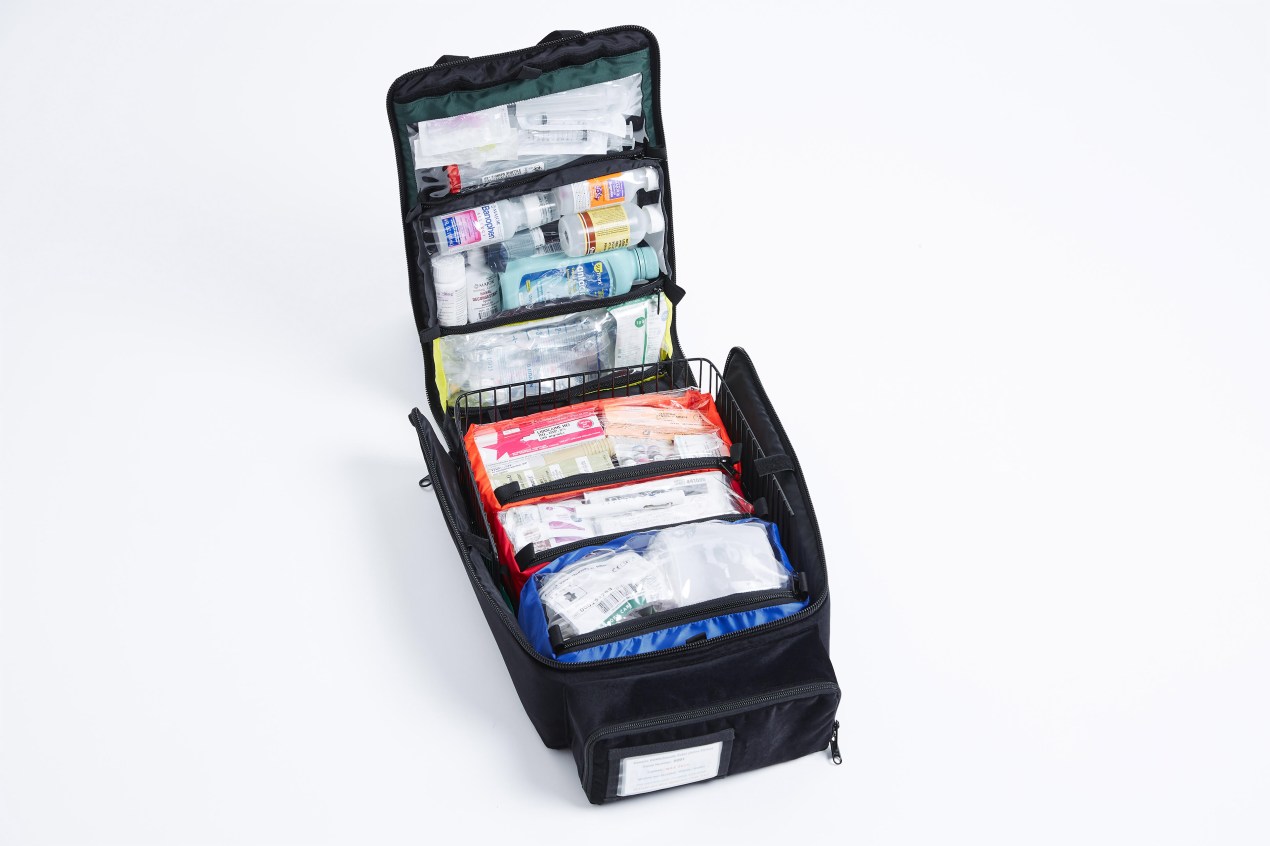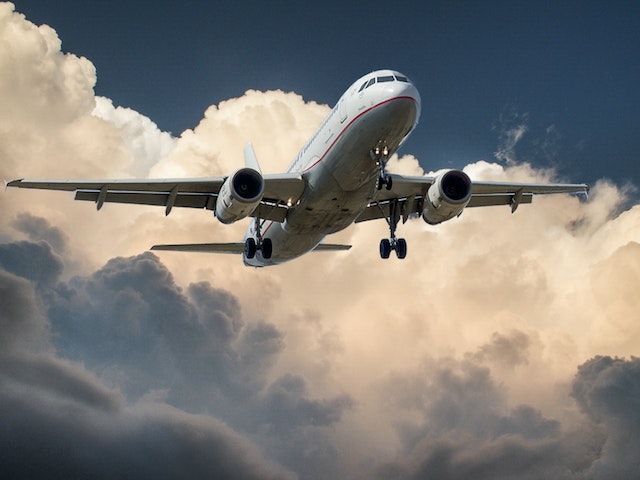2023-01-08
During In-Flight Emergencies, Sometimes Airlines’ Medical Kits Fall Short

Commercial airplanes are required to carry sealed emergency medical kits, like the one pictured, that contain specific equipment and medications. But health professionals who have volunteered to help in in-flight emergencies say the kits can be inadequate and are sometimes missing required items. (MEDAIRE)
In March, a Frontier Airlines flight was headed from Phoenix to Las Vegas when a female passenger stopped breathing. The flight attendant yelled in the cabin for help.
A passenger who was trained as a wilderness first responder, Seth Coley, jumped into action and found the woman was unresponsive and had a weak pulse. Coley dug through the plane’s medical kit but couldn’t find an oropharyngeal airway, a tool that was supposed to be there and that he needed to help the woman breathe. Instead, he cleared the airway by manipulating her neck.
Afterward, Coley sent a message to Denver-based Frontier Airlines via an online customer service form: “I saved somebody’s life on one of your flights,” he wrote. “I would like to speak about the medical kit you guys have on your flights. You are missing some very valuable and simple things. She almost died.”
Americans are flying at levels reaching pre-pandemic numbers. While covid-19 ushered in new health and cleaning protocols designed to make airplane travel safer, incidents like Coley’s raise questions about airlines’ readiness for medical emergencies because of incomplete or insufficient medical kits and the training of flight crews, who often rely on other passengers in emergencies.
Frontier did not respond to KHN’s requests for comment about that incident or its emergency kits. But Coley’s experience illustrates the risks travelers take every time they board a flight. For every 20,000 passengers who take a flight on a U.S.-based airline, there is one medical event — defined as any health-related incident, not only emergencies — according to estimates from airplane medical services company MedAire.
The Federal Aviation Administration requires commercial aircraft to carry at least one sealed emergency medical kit containing a minimum of 25 specified instruments and medications, plus first-aid kits and automated external defibrillators. But the FAA does not track data on the use of those kits during in-flight medical emergencies. Instead, the agency leaves it to the airlines to inspect the kits and replace them if the seals are broken.
“Ensuring complete, sealed emergency medical kits are present is part of the cabin crew’s preflight inspection,” FAA spokesperson Ian Gregor said in a statement.
But, as Coley and other passengers who have responded to an in-flight emergency have found out, an item required in a medical kit can sometimes be missing. Some items the FAA doesn’t require, such as the overdose reversal drug naloxone, are carried voluntarily by some airlines. The agency has issued guidance recommending items to add to the kits, but they are not yet mandated.
Gregor said the FAA investigates all reports of issues with medical kits and ensures any concerns are addressed. He did not respond to a KHN request for details on the number of reports investigated, their outcomes, or whether the emergencies described in this article were among those investigated.
In June, Boston surgeon Dr. Andrea Merrill was aboard a Delta Air Lines flight when she assisted in a medical emergency and found the kit fell short of what she needed.
It needs “a glucometer, epi pen, and automatic blood pressure cuffs — it’s impossible to hear with a disposable stethoscope in the air,” Merrill tweeted to Delta after the incident. “Please improve this for passenger safety!”
After Merrill’s tweet went viral, Delta followed up with her, saying it would switch to automatic blood pressure cuffs and “real” stethoscopes, as well as consider glucometers at gates. Merrill declined an interview request.
KHN asked U.S. airlines to detail their medical emergency protocols and the contents of their medical kits. Seven responded with limited information: Alaska, Allegiant, Hawaiian, JetBlue, Southwest, Sun Country, and United. All said that their kits meet or exceed FAA requirements and that they train their staff to respond to medical emergencies. Many airlines also contract with a MedAire service called MedLink that connects flight crews with a medical professional on the ground in an in-flight emergency.
Allegiant officials said passengers with medical conditions should not assume their planes will have everything they need in an emergency. “Although our crews are trained to respond to a wide array of unplanned medical emergencies, we want to remind readers who have anticipated medical needs to bring their own medical supplies in carry-on luggage and not rely on aircraft emergency equipment,” Allegiant spokesperson Andrew Porrello said in a statement.
Delta, along with American, Frontier, and Spirit, did not respond to requests for comment. A 2019 article on the Delta website said its flight attendants are given training in first aid and CPR. Additionally, Delta wrote that its medical equipment exceeds FAA requirements. The airline mentioned it uses STAT-MD, a service that lets flight crews consult with trained personnel at the University of Pittsburgh Medical Center.
The FAA requires flight attendants to receive specific medical training, but medical professionals who have intervened as passengers during an in-flight emergency said the crew is not always quick to respond.
“Passengers believe that there are probably more safeguards in place than there actually are,” said Dr. Comilla Sasson, a Denver-area emergency physician and associate clinical professor at the University of Colorado.
Sasson was on a United Airlines flight in 2018 when a passenger passed out. When she volunteered to help, crew members asked for proof that she was a doctor as she mobilized to check the passenger’s vital signs. Sasson questioned the extent to which crew members are trained to help in medical emergencies, saying other health care providers have told her about their own experiences of aiding a passenger in need while the flight personnel stood aside.
“It’s interesting to me that the airlines really kind of depend on the kindness of strangers in a lot of ways, much more so than I would think,” Sasson said.
The goodwill of a fellow passenger is something Bay Area resident Meera Mani is thankful for after a 2011 experience. She was on a United flight from Toronto to San Francisco when her now-deceased father, then in his 80s, began showing concerning symptoms: The right side of his face and arm drooped. Worried her dad was having a stroke, Mani shouted for help but was frustrated by flight attendants’ slow response.
“And then finally, I said: ‘Is there a doctor on the flight?’” Mani recounted.
There was. The doctor used a defibrillator to stabilize her father.
“It was very clear to me that the [flight] staff were completely flummoxed,” Mani said. “They had the equipment, they took it out, they gave it to him, but the doctor took care of it.”
United helped organize an ambulance to meet Mani and her father on the ground at the San Francisco airport and later called to see if her dad was OK. He ended up being diagnosed with a condition that could lead to fainting.
MedAire, which runs the MedLink consulting service, said it covers around 70% of the U.S. market but declined to specify airlines. Dr. Paulo Alves, MedAire’s global medical director of aviation health, said 98% of medical events are managed on board and are non-life-threatening, while 2% are serious cases that might divert a flight.
Alves said his company also provides medical consultations before passengers board a flight.
“An airplane — although I love aviation — is never the best place for you to have a medical event,” Alves said. “The first line of prevention is actually preflight.”
Alves also defended the contents of airlines’ medical kits. The medically trained volunteers who step in to help fellow passengers in an emergency may expect resources available in a hospital, but “the airplane is not a hospital. You cannot carry everything,” he said.
Mani said she would like to see airlines disclose which medical emergencies they’re trained to address — potentially on flight safety cards. Sasson said it would be helpful if airlines clearly shared information about what medical supplies are available on board.
“I think the general public doesn’t realize how much of a crapshoot it is when they’re up in the air that somebody with some sort of medical training will know what to do, if something were to happen,” Sasson said.
KHN (Kaiser Health News) is a national newsroom that produces in-depth journalism about health issues. Together with Policy Analysis and Polling, KHN is one of the three major operating programs at KFF (Kaiser Family Foundation). KFF is an endowed nonprofit organization providing information on health issues to the nation.

